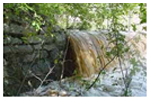 |
|
Please note: This summary is provided to help you understand the regulations. Consult the references provided for links to the full text of the regulations.
This section provides information about rules that regulate stormwater from transportation facilities and construction activities. Who is covered by the regulations? The term "Storm Water Discharges Associated with Industrial Activity", defined in federal regulations 40 CFR 122.26(b)(14)(i)-(xi), determined which industrial facilities are potentially subject to the stormwater regulations. The definition uses either SIC (Standard Industrial Classification) codes or narrative descriptions to characterize the activities. Among the listed industrial activities are transportation facilities classified by the SIC codes listed below which have vehicle maintenance shops, equipment cleaning operations, or airport deicing operations. Only those portions of the facility that are either involved in vehicle maintenance (including vehicle rehabilitation, mechanical repairs, painting, fueling, and lubrication), equipment cleaning operations, airport deicing operations, or which are otherwise identified under other categories are associated with industrial activity, and need permit coverage. The applicable SIC codes include:
Additionally, many construction activities associated with transportation operations (i.e., those that disturb 1 acre or more) must comply with construction stormwater regulations and must obtain coverage for those activities under a separate construction stormwater permit. Construction activities can include road building, construction of office buildings, industrial sites, or demolition. What is the purpose of the regulations? Every inch of rain on an acre of asphalt generates over 27,000 gallons of water. Areas used for such activities as vehicle and equipment maintenance, parking, or material handling and storage, tend to collect contaminants that are picked up in the stormwater. The runoff from these areas may discharge pollutants directly into nearby water bodies, or indirectly via storm sewer systems, thereby degrading water quality. The regulations require that a Stormwater Pollution Prevention Plan (SWPPP) be prepared and implemented to reduce the impacts of stormwater discharges from industrial activity. Regulations - Stormwater associated with industrial activities In 1990, the U.S. Environmental Protection Agency (EPA) developed permitting regulations (40 CFR 122.26) under the National Pollutant Discharge Elimination System (NPDES) to control stormwater discharges associated with eleven categories of industrial activity, including transportation (see EPA Stormwater Program). As a result, all facilities that meet the definition of "Storm Water Discharges Associated with Industrial Activity", must either:
The no-exposure certification alternative is available for a facility that is able to show that its industrial activities, even though covered under the regulations, are never exposed to precipitation. In that case, the facility may be eligible to claim no exposure and qualify for a waiver from permit coverage. Throughout most of the nation, EPA has delegated the stormwater program to the states to administer as they deem appropriate, so long as minimum federal requirements are met (see State Authorization status). Therefore, in most states you will apply for a permit or submit your no exposure certification or permit application to your state environmental agency. However, some states do not yet have the authority to administer this program. For the following states, you will probably need to submit your certification or permit application to your Regional EPA office: Alaska, Idaho, Massachusetts, New Hampshire Texas, Florida, Maine, and Arizona. If your facility is in one of these states, we suggest contacting both your Regional EPA office and state agency to find out where to submit your paperwork. For more information on state rules regarding industrial stormwater discharges use the Industrial Stormwater Resource Locator. Regulations - Stormwater associated with construction activities Stormwater runoff from construction activities can have a significant impact on water quality. As stormwater flows over a construction site, it can pick up pollutants like sediment, debris, and chemicals and transport these to a nearby storm sewer system or directly to a river, lake, or coastal water. Polluted stormwater runoff can harm or kill fish and other wildlife. The NPDES stormwater program requires construction site operators engaged in clearing, grading, and excavating activities that disturb 1 acre or more to obtain coverage under an NPDES permit for their stormwater discharges. Although these are federal rules, they are implemented by state environmental agencies (except for Massachusetts, New Mexico, Alaska, Idaho and New Hampshire where EPA retains authority). To obtain forms and more information on application procedures and permit requirements for construction projects in your state, use the CICA Stormwater Resource Locator (SWRL). If you are regulated under the industrial permitting program, you must either obtain permit coverage or submit a no exposure certification form. Most companies qualify for coverage under a state or federal general stormwater permit. To become eligible for permit coverage, a company must submit a Notice of Intent (NOI, which is similar to an application form), develop a Stormwater Pollution Prevention Plan (SWPPP) and install stormwater control measures to minimize pollutants in stormwater runoff. Guidance on SWPPP development is available from EPA and most states. See EPA SWPPP Guidance for Stormwater from Industrial Activities and EPA SWPPP Guidance for Stormwater from Construction Activities. The impacts of stormwater discharges can be mitigated through implementation of best management practices (BMPs). Typically, applicable BMPs are incorporated into the SWPPP for a given facility. BMPs can be found in the literature or guidance documents published by EPA and state environmental agencies. Useful sources include:
Road Salt Application and Storage. EPA fact sheet covering siting and design considerations for salt storage. Construction Industry Compliance Assistance Center (CICA Center) - Provides an extensive resource for stormwater associated with construction activities. Industrial Stormwater Resource Locator - Includes information on state rules regarding industrial stormwater discharges.
|
 Stormwater Regulations
Stormwater Regulations